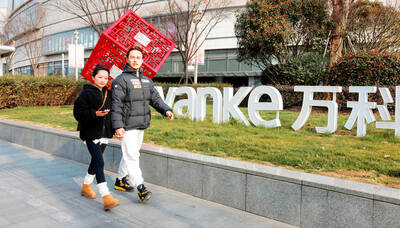Amazon.com Inc told Wall Street that it would have to spend billions of dollars hiring workers, paying them more and even speeding partly empty trucks to their destinations to ensure that supply-chain snarls do not derail the holiday shopping season.
The massive outlays could wipe out Amazon’s profit during the last three months of the year, executives said. The company also reported third-quarter revenue and earnings that fell short of projections. The shares declined about 4 percent in extended trading.
Revenue is expected to be US$130 billion to US$140 billion in the period ending in December, the Seattle company said on Thursday in a statement. On average, analysts estimated US$141.6 billion, data showed.
Operating income could be as low as zero, Amazon said, a step back for the company after reaping billions of dollars in profit each quarter going back to early 2018.
The results reflected the first period under new CEO Andy Jassy, who took the helm of the world’s largest online retailer from Jeff Bezos in July. Amazon shares have gained 5.8 percent this year, underperforming the broader market, as consumers who turned to online ordering in record numbers during the COVID-19 pandemic began to resume in-person shopping, eating out and traveling.
Amazon had signaled that slower sales growth, and high spending in areas such as wages and new warehouses, would persist through the end of the year.
“Consumers have started to return to pre-pandemic spending patterns,” chief financial officer Brian Olsavsky said.
Amazon is dispatching to a greater extent partly empty trucks, sending products on more circuitous routes and speeding some shipments to make sure that customers get their items within the company’s promised windows.
While Amazon earlier this week sought to reassure shoppers and shareholders that its investments left it well prepared to weather the global supply chain woes, Jassy said the expansion would come at a cost.
“In the fourth quarter, we expect to incur several billion dollars of additional costs in our consumer business as we manage through labor supply shortages, increased wage costs, global supply chain issues, and increased freight and shipping costs,” he said in the statement. “It’ll be expensive for us in the short term, but it’s the right prioritization for our customers and partners.”
Supply chain and labor pressures could mean Amazon cannot deliver goods to customers as fast as usual, or that some hoped-for items might not be available despite the company’s extra spending, Capital Markets analyst Ed Yruma said.
“They’re going to have to step up hiring,” Yruma said. “It’s more expensive, and those ‘out-of-stocks’ are going to be more severe than people expect.”
Amazon employed more than 1.46 million full-time and part-time workers as of Sept. 30, a 30 percent increase from a year earlier. New-hire bonuses and wage increases added US$1 billion to the company’s expenses during the third quarter, and that cost could likely double during the holiday period, Olsavsky said.
Third-quarter revenue increased 15 percent to US$110.8 billion, compared with analysts’ average estimate of US$111.8 billion. Earnings were US$6.12 per share, down from US$12.37 a year earlier, the company said.
Investors were hoping that conditions would have improved since Amazon’s relatively gloomy outlook in July, M Science director of research John Tomlinson said.

CHIP RACE: Three years of overbroad export controls drove foreign competitors to pursue their own AI chips, and ‘cost US taxpayers billions of dollars,’ Nvidia said China has figured out the US strategy for allowing it to buy Nvidia Corp’s H200s and is rejecting the artificial intelligence (AI) chip in favor of domestically developed semiconductors, White House AI adviser David Sacks said, citing news reports. US President Donald Trump on Monday said that he would allow shipments of Nvidia’s H200 chips to China, part of an administration effort backed by Sacks to challenge Chinese tech champions such as Huawei Technologies Co (華為) by bringing US competition to their home market. On Friday, Sacks signaled that he was uncertain about whether that approach would work. “They’re rejecting our chips,” Sacks

Taiwan’s long-term economic competitiveness will hinge not only on national champions like Taiwan Semiconductor Manufacturing Co. (TSMC, 台積電) but also on the widespread adoption of artificial intelligence (AI) and other emerging technologies, a US-based scholar has said. At a lecture in Taipei on Tuesday, Jeffrey Ding, assistant professor of political science at the George Washington University and author of "Technology and the Rise of Great Powers," argued that historical experience shows that general-purpose technologies (GPTs) — such as electricity, computers and now AI — shape long-term economic advantages through their diffusion across the broader economy. "What really matters is not who pioneers

BUBBLE? Only a handful of companies are seeing rapid revenue growth and higher valuations, and it is not enough to call the AI trend a transformation, an analyst said Artificial intelligence (AI) is entering a more challenging phase next year as companies move beyond experimentation and begin demanding clear financial returns from a technology that has delivered big gains to only a small group of early adopters, PricewaterhouseCoopers (PwC) Taiwan said yesterday. Most organizations have been able to justify AI investments through cost recovery or modest efficiency gains, but few have achieved meaningful revenue growth or long-term competitive advantage, the consultancy said in its 2026 AI Business Predictions report. This growing performance gap is forcing executives to reconsider how AI is deployed across their organizations, it said. “Many companies

China Vanke Co (萬科), China’s last major developer to have so far avoided default amid an unprecedented property crisis, has been left with little time to keep debt failure at bay after creditors spurned its proposal to push back a looming bond payment. Once China’s biggest homebuilder by sales, Vanke failed to obtain sufficient support for its plan to delay paying the 2 billion yuan (US$283.51 million) note due today, a filing to the National Association of Financial Market Institutional Investors showed late on Saturday. The proposal, along with two others on the ballot, would have allowed a one-year extension. All three